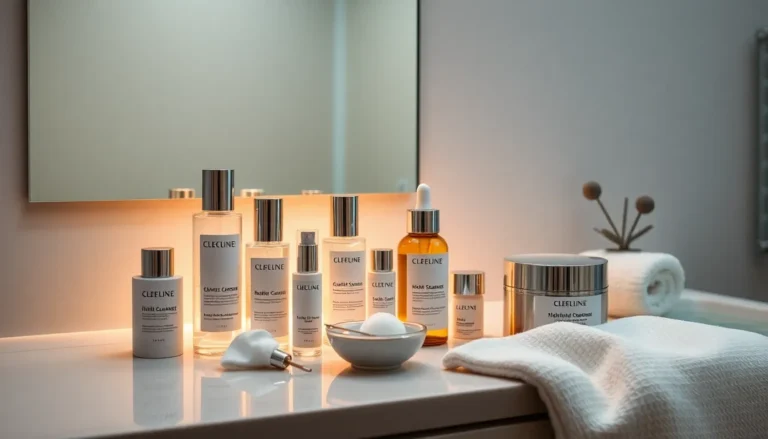Table of Contents
ToggleIf oily skin were an award show, it would take home the Oscar for Most Dramatic. Constantly shining, splattering product everywhere, and leaving its mark (literally) on everything it touches, it can be a tough diva to handle. But fear not. This guide is here to help navigate the glistening realm of oily skin with confidence, humor, and a sprinkling of science. Whether dealing with unexpected breakouts or a slick complexion, mastering the right skincare routine can make all the difference in achieving that healthy glow without the grease shine. Grab your notepad and let’s jump into the secrets of maintaining clear, fabulous skin while embracing the shine, after all, who doesn’t love a good glow-up?
Understanding Oily Skin

Common Causes of Oily Skin
Oily skin often feels like a natural disaster zone, but understanding its causes can help manage it better. Genetics plays a pivotal role, with many people inheriting this condition, thanks to mom or dad’s shiny legacy. Hormonal changes, particularly during puberty or menstrual cycles, also crank up oil production. Stress? Yes, it’s a major player too, throwing complexion harmony out the window in favor of a more greasy backdrop. Finally, environmental factors like humidity can cause oil glands to go into overdrive, cranking up the shine meter significantly.
Identifying Oily Skin
Recognizing oily skin isn’t rocket science. Just step into daylight and take a peek in the mirror. If the T-zone, forehead, nose, and chin, shimmers like a disco ball within a few hours of cleansing, it’s safe to say oily skin is the culprit. Other telltale signs include enlarged pores and the frequent appearance of blackheads and acne. Does skincare product application slide off like a banana peel? That’s another indicator. Overall, oily skin requires specific attention, making the right routine essential for combating the shine and maintaining balance.
Essential Components of a Skincare Routine
Cleansing Techniques for Oily Skin
A clean canvas is vital for oily skin, yet not all cleansers are created equal. Foaming cleansers, particularly those containing salicylic acid, work well to strip excess oil without over-drying. Those with oily skin should cleanse twice daily, trust us, this isn’t a suggestion but a necessity. Double cleansing with an oil-based cleanser can remove makeup, leaving a fresh slate for the second round of cleansing with a gel or foam option.
Toners That Balance Oil Production
Toners can be a game changer for oily skin. Look for alcohol-free formulas containing witch hazel, tea tree oil, or rosewater. These magical potions balance out oil production and provide hydration without the greasy aftermath. Utilizing a toner after cleansing can reduce pore visibility, helping achieve smoother skin while preparing the face for the next steps in the routine.
Moisturizing Oily Skin: Myths and Facts
There’s a persistent myth that oily skin doesn’t need moisturizing, and that’s completely false. In fact, opting for a lightweight, oil-free moisturizer is crucial. These products hydrate without clogging pores, enabling the skin to maintain moisture balance, so helping to regulate oil production. Ingredients like hyaluronic acid and glycerin are excellent for achieving hydration without that heavy feel.
Exfoliation and Its Importance
Exfoliation is a non-negotiable part of an oily skincare routine. Regularly sloughing off dead skin cells speeds up cell turnover and helps prevent clogged pores. Incorporating chemical exfoliants, like AHAs or BHAs, two to three times a week can work wonders. But, it’s crucial to balance this to avoid irritation. Listen to your skin, it knows best.
Treatment Options for Oily Skin
Over-the-Counter Products
Many over-the-counter options are available for managing oily skin, focusing on ingredients like salicylic acid, benzoyl peroxide, or retinoids to combat breakouts. Clay masks can also be effective, as they draw out impurities while absorbing excess oil. When it comes to choosing products, patience is vital. Finding the right combination might take some trial and error, but persistence is key in achieving that ideal balance.
Consulting a Dermatologist
If the battle against oily skin seems relentless, consulting a dermatologist can provide invaluable insights. They can suggest targeted treatments or prescribe medications for more severe cases. Customized advice can lead to more effective results as a professional examination can uncover unique aspects of an individual’s skin type.
Lifestyle Tips for Managing Oily Skin
Dietary Considerations
Diet plays a significant role in skin health, especially for oily skin. Consuming a balanced diet rich in fruits, vegetables, and whole grains contributes to overall skin health. Reducing sugar and dairy can help decrease oil production, as certain foods can trigger breakouts and exacerbate oiliness. Staying hydrated is equally important: adequate water intake helps flush out toxins and maintain skin hydration from within.
Stress Management
Stress is commonly linked to skin issues, including increased oiliness and breakouts. Practicing stress management techniques like yoga, meditation, or even leisure walks can significantly reduce stress levels, resulting in calmer skin. Activities that promote relaxation contribute not just to well-being but also foster a healthier complexion.




